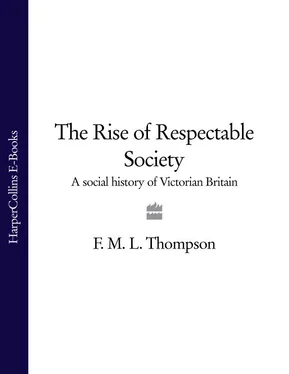1 ...7 8 9 11 12 13 ...25 The engineering shops and the works producing or fabricating metals were in the vanguard also of the urbanization of industry. But whereas the heavy end of the industry, particularly the making of iron and steel, was tightly bound to the coalfields by its high fuel consumption, much engineering work with its high skilled-labour content was not equally constrained. The result was that iron and steel works tended to generate towns around themselves, while engineering and metalworking tended to grow where there were existing supplies of skilled labour, external economies in the form of supporting trades and services, and easy access to final markets, thus reinforcing and diversifying already large towns. Manchester and Leeds, Clydeside and Tyneside, became important centres for machine tools and other kinds of engineering, building outwards from core interests in textile machinery, shipbuilding, colliery equipment, and locomotives. London, far from any coalfield, was however the pioneer of mechanical engineering in the 1820s, and although technical leadership may have passed to the northern towns after mid-century it continued to have a larger mechanical engineering industry than any other region except Lancashire until after 1871, an industry which went on growing to the end of the century and beyond. In the much smaller industry of instrument-making, with its large handicraft element, London held a preeminent position throughout the century, while in the new occupation of the 1880s, electrical engineering, it at once established dominance: such were the advantages of a large pool of highly skilled workers and an enormous market on the doorstep. The pulling power of the large towns should not be exaggerated. In such a specialized business as the making of agricultural machinery, proximity to the customers and direct knowledge of their requirements helped manufacturers to flourish in country towns like Lincoln, Grantham, Peterborough, Ipswich, Bedford, or Banbury, and to live with their competitors in Leeds or Manchester; but by the last quarter of the century firms with such country locations were supplying national and international markets, showing ability to outgrow any narrowly local initial locational factors and to ignore any apparent disadvantages of distance from their supplies of raw materials and fuel. It has been in the twentieth century that the spread of electric power has severed the umbilical cord tying engineering – and industry generally – to coalfield sites; but the link was not universally binding even in the full flush of steam power.
Large towns also had a strong but not overpowering attraction for other sectors of manufacturing industry. Some of these, although not large employers of labour in national terms, were well established as factory-type industries by the 1830s because of their large and costly plant, and were concentrated in a few areas with favourable access to resources, where they could be of great importance in the local economy. The pottery, glass, and chemical industries are cases in point, with their concentrations in the five towns of the Potteries, Merseyside, Tyneside, and Clydeside. The woodworking industry, by contrast, employing roughly as many people as these other three throughout the period, was widely diffused. It was in effect a bundle of trades and crafts, from cabinet-makers and french polishers to willow-strippers and hurdle-makers, and like these last some remained parts of rural woodland economies. The chief effect of the growth of urban population and markets, however, was to stimulate the woodworking trades in towns generally, through a proliferation of workshops, small businesses, and outworkers, rather than through any rise of furniture factories.
The basic consumer industries, those concerned with processing food, drink, and tobacco, presented a mixed pattern of development of the growth of large enterprises using factory methods alongside both the survival of slowly declining traditional producers, and the multiplication of new small businesses. This group consistently held fourth place as an employer of workers in manufacturing, after textiles, clothing, and metals and engineering; and its steady rise in relative size after 1871, to reach over 15 per cent of the manufacturing workforce by the end of the century, was a reflection of the commercialization of much food preparation and preserving which had previously been part of the household economy, as well as of a general increase in consumption. The Kellogg effect, or cornflakes revolution, was by this time under way, and in sweets and biscuits, cigarettes or margarine, it was in the late Victorian years that Cadbury and Rowntree, Huntley and Palmer, Wills and Player, and Lever were establishing themselves as household names. Much of the expansion of demand, however, perhaps particularly before the 1880s, was met by a simple increase in the numbers of small bakeries, confectioners’ shops, and the like; indeed many processes long continued to be performed behind the shop counter, and it was not until the early twentieth century that a clear-cut distinction between manufacture on the one hand, and distribution and retailing on the other, became normal in the food trades. In corn-milling also the dramatic changes came in the 1880s. Steam mills were established in the larger towns earlier in the century, using traditional millstones, but they did not make serious inroads into the trade of windmills and watermills. The perfection of roller-grinding, coupled with the rise in wheat imports, led to rapid growth of giant flour mills in the major wheat-importing ports, London, Liverpool, and Hull, in the decade or so after 1881. Even so, although country milling came under pressure, its decline was not precipitous, and as late as 1907 not far short of a quarter of all the power used in flour-milling was still provided by water.
Manufacturing occupied the centre of the stage in the industrial economy which was consolidated during the Victorian period. Machines, factories, and power were the key elements in innovation and productivity growth, and catch the eye of the historian as they did of contemporaries on account of their novelty, modernity, and success. The phasing of the introduction of factory methods over a long period, with steady diffusion in the third quarter of the century and a decided burst from the 1880s, coupled with the survival of pre-factory methods of production and the creation of new non-factory trades, means however that the overall social impact of manufacturing industry was much more diverse and complex than the straightforward creation of a factory proletariat. In any event one of the apparent paradoxes of industrialization is that the share of manufacturing industry as a whole in the national workforce did not increase over the century; it may possibly have been rising in the early decades of the nineteenth century, but from the 1840s onwards its share remained remarkably constant at around one third of the occupied population, although there were the considerable shifts between different sectors within manufacturing that have been noted. The relative decline of agriculture was inexorable, although the actual numbers employed in farming went on rising slowly until 1851; thereafter absolute numbers fell by 100,000 or more every decade, with the result that agriculture’s share of the labour force declined from a quarter to a fifth between 1831 and 1851, and had dropped to under 9 per cent by 1901. This was the shrinking sector of the economy. Since the manufacturing sector did not expand, relatively, it can be argued that the net effect of the restructuring of the Victorian economy was the redistribution of some 16 per cent of the labour force away from agriculture and into non-manufacturing, expanding, sectors.
Most of this expansion took place in the service sectors of the economy, commerce, transport, the professions, central and local government service, and domestic and personal service; some of it was in mining and quarrying, and building and construction, usually classified as non-manufacturing industries. In terms of economic analysis part of this expansion can be viewed as a necessary condition of the course of industrialization, and part as a consequence of generally rising incomes. Manufacturing clearly depended on increasing inputs from mining and building, and on more elaborate and sophisticated transport and commercial services; and, towards the end of the century, on more specialized services, in accountancy or advertising maybe, which industrialists had once supplied for themselves. The capacity of manufacturing to produce an enormous increase in industrial output from an unchanging share of the labour force depended – apart from its own internal rise in labour productivity through mechanization – upon the relative expansion of those sectors where labour productivity actually fell, as in mining, scarcely altered, as in building, or rose much less rapidly, as in the provision of services. If it were possible to quantify these elements of expansion, they could be accounted transfers out of agriculture for the necessary support of manufacturing. On the other hand, some part of the expansion in building went to providing better housing, in transport to increasing and widening the opportunities for personal travel, and in other services to providing more education and health and more employment in entertainment, leisure, and holiday occupations. This part of the restructuring was an expression of the ways in which increasing wealth and incomes were enjoyed. In terms of social analysis, however, the prime interest of these expanding sectors lies more in their individual characteristics than in the identification of the different economic forces at work: a railwayman was a railwayman, up to a point, whether shunting coal wagons or driving an excursion train.
Читать дальше












